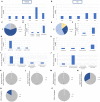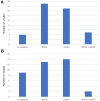Grimace scale, burrowing, and nest building for the assessment of post-surgical pain in mice and rats-A systematic review
- PMID: 36277074
- PMCID: PMC9583882
- DOI: 10.3389/fvets.2022.930005
Grimace scale, burrowing, and nest building for the assessment of post-surgical pain in mice and rats-A systematic review
Abstract
Several studies suggested an informative value of behavioral and grimace scale parameters for the detection of pain. However, the robustness and reliability of the parameters as well as the current extent of implementation are still largely unknown. In this study, we aimed to systematically analyze the current evidence-base of grimace scale, burrowing, and nest building for the assessment of post-surgical pain in mice and rats. The following platforms were searched for relevant articles: PubMed, Embase via Ovid, and Web of Science. Only full peer-reviewed studies that describe the grimace scale, burrowing, and/or nest building as pain parameters in the post-surgical phase in mice and/or rats were included. Information about the study design, animal characteristics, intervention characteristics, and outcome measures was extracted from identified publications. In total, 74 papers were included in this review. The majority of studies have been conducted in young adult C57BL/6J mice and Sprague Dawley and Wistar rats. While there is an apparent lack of information about young animals, some studies that analyzed the grimace scale in aged rats were identified. The majority of studies focused on laparotomy-associated pain. Only limited information is available about other types of surgical interventions. While an impact of surgery and an influence of analgesia were rather consistently reported in studies focusing on grimace scales, the number of studies that assessed respective effects was rather low for nest building and burrowing. Moreover, controversial findings were evident for the impact of analgesics on post-surgical nest building activity. Regarding analgesia, a monotherapeutic approach was identified in the vast majority of studies with non-steroidal anti-inflammatory (NSAID) drugs and opioids being most commonly used. In conclusion, most evidence exists for grimace scales, which were more frequently used to assess post-surgical pain in rodents than the other behavioral parameters. However, our findings also point to relevant knowledge gaps concerning the post-surgical application in different strains, age levels, and following different surgical procedures. Future efforts are also necessary to directly compare the sensitivity and robustness of different readout parameters applied for the assessment of nest building and burrowing activities.
Keywords: MGS; RGS; facial expression; home cage behavior; pain assessment; rodents.
Copyright © 2022 Aulehner, Leenaars, Buchecker, Stirling, Schönhoff, King, Häger, Koska, Jirkof, Bleich, Bankstahl and Potschka.
Conflict of interest statement
The authors declare that the research was conducted in the absence of any commercial or financial relationships that could be construed as a potential conflict of interest.
Figures






References
-
- European Commission. Working Document on a Severity Assessment Framework. Brussels: European Commission; (2012).
-
- Jirkof P, Potschka H. Effects of untreated pain, anesthesia, and analgesia in animal experimentation. In: Sánchez Morgado JM, Brønstad A, editors. Experimental Design and Reproducibility in Preclinical Animal Studies. Cham: Springer; (2021). p. 105–26. 10.1007/978-3-030-66147-2_5 - DOI
Publication types
LinkOut - more resources
Full Text Sources

